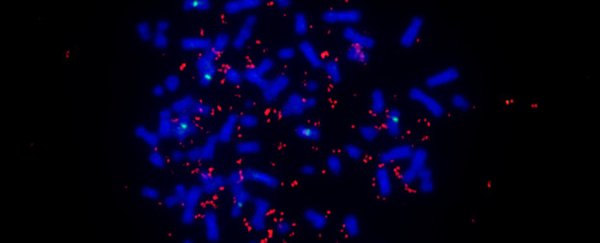Cancer sucks, in no small part because many types of tumour eventually develop a knack for dodging our best treatments.
But researchers have now figured out why some cancers have this talent - they store copies of their genes away from our chromosomes, where they no longer have to play by the rules.
Most of our cell's gene-encoding DNA is wrapped up tight as super-long molecules called chromosomes. We have 46 of them, defined as 23 pairs, which are typically duplicated and distributed evenly as our cells replicate.
Inside cellular organelles called mitochondria we also have some circular segments of DNA. These are also shared out fairly evenly.
On rare occasions, extrachromosomal DNA (ecDNA) can also be found floating through a cell. Though usually short, these circular segments of nucleic acid can be over 20,000 base pairs in size, often containing repetitive sequences copied from a chromosome.
What they do is anybody's guess, with most speculation focussing on helping keep the rest of the genetic library stable in some way.
While ecDNA has been spotted in certain types of cancer tissue since the 1960s, the tools to measure it in detail weren't sharp enough to understand its prevalence until recently.
Fast forward to 2014, when researcher Paul Mischel from the Ludwig Institute from Cancer Research found ecDNA played a key role in a type of brain tumour called glioblastoma developing resistance to certain drugs.
Usually when researchers want to study the resistance of cancers, they want to know how the cancer-causing gene works. The gene's location hasn't been all that important.
Mischel's research suggested 'where' the gene is found could be as important as knowing 'what' it does.
"It occurred to us after we made the observations published in 2014 that maybe ecDNA is a lot more common and consequential than anyone thought," Mischel says.
In their most recent research, Mischel's team analysed a few thousand cells from 117 tumour cell lines derived from patients, eight non-cancerous samples derived from other volunteers, and 10 non-cancerous existing cell lines.
Using a range of modelling and clinical tools typically used in fields of cytogenetics, genomics, and bioinformatics, Mischel and his team discovered ecDNA in between 40 and 90 percent of the tumour cell lines they analysed.
Intriguingly, almost no ecDNA was detected in the non-cancerous cells.
The next step was to find out what was on these free-floating rings of DNA.
By sequencing the tumour cell's genomes and applying a molecular probing tool called fluoro in-situ hybridisation, the researchers found genes typically associated with those tumour types encoded on the ecDNA.
Genes that have the potential to mutate and contribute to the formation of a cancer are known as oncogenes.
Unlike chromosomal DNA and mitochondrial DNA, ecDNA doesn't play by the usual rules of distribution as the parent cell reproduces. Daughter cells can either scoop up a bunch of them, share a few, or inherit barely any.
A computer model was used to simulate ways ecDNA could spread through the replication of cancer cells. By distributing its oncogenes unevenly, the tumour becomes a mixed-bag of diverse kinds of cells.
Variety being not only the spice of life, but the armour of cancer, it suggests these cancers have found a way to get around the limitations imposed by the usual way genes are distributed on chromosomes.
Cells with the right combinations of genes have a higher chance of resisting the barrage of toxins used in chemotherapy to knock down fast-growing tumours. Having all cells with the same combinations of genes is like buying a hundred of lottery tickets all with the same numbers.
In other words, while most cells would die, the few cells with 'lucky numbers' could survive to repopulate.
"We found that if an oncogene was on ecDNA, it could far more rapidly reach high levels and that those high levels would be maintained much longer than if it were just on the chromosome," Mischel explained to The Scientist.
Most searches currently performed for oncogenes associated with resistance won't pick up sequences hiding on ecDNA.
Knowing the role these lurking loops of DNA play in the evolution of a cancer can provide us with better avenues for making effective diagnostic and prognostic tools.
The next step for Mischel and his team is to identify the mechanisms tumours use to make and maintain their copies of ecDNA. With the right drugs, maybe we can at least force these cancers to fight fair.
This research was published in Nature.
